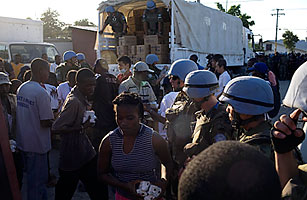
U.N. soldiers give out crackers to refugees from the earthquake in Port-au-Prince, Haiti, on Jan. 17, 2010
Michaud Jonas, 27, came to the flattened Palm Apparel factory in part to see if he could find his little sister's body — and in part to find work. Jonas' sister was one of hundreds trapped beneath the rubble of the T-shirt plant, perhaps the largest loss of life in a single building in a country full of death. By some accounts, the factory employed 2,000 people, and about half were pulled from the rubble right after the earthquake that has claimed tens of thousands of Haitian lives since Jan. 12. Palm's death toll may be several hundred, but there is no practical way to come up with an accurate count.
"Here was the worst place hit, so maybe it'll be the first to recover," reasons Jonas, standing next to the crushed factory. The scent of death that permeates the neighborhood is so strong, it's like a double fist to the stomach. It's hard not to gag. Although Jonas mourns his sister — as well as the loss of his brother and mother, who died when the family's home collapsed — he says it's time to move on. "I need to find a job so I can help what's left of my family. They are depending on me."
Like Jonas, much of Haiti is trying to move on, slowly and painfully, often with a limp or a bandaged head or arm. The living are walking wounded, and though shell-shocked and scarred for life, they know they are the lucky ones. "Only God keeps us from death," says Mark Henry, 37, standing before Katherine Flon High School in the Carrefour neighborhood. Hundreds of students lie beneath the rubble. "If you weren't spiritual before, this situation made you so."
Rescue teams are still desperately searching for survivors, and beneath a few ruins, there are some faint signs of life. So far 71 survivors have been pulled from the remains of crushed buildings. But the priority is shifting to relief for those left alive, says Nicholas Reader, spokesman for the U.N. Offices for the Coordination of Humanitarian Affairs.
The U.N. World Food Program is hoping to be able to feed 2 million people, about one-fifth of the country, by the end of the month. It started on Monday with 89,000 people — a process that went surprisingly smoothly. The U.N. is also working to provide cans, so people can fill them with water at the roving water tanks, now a common sight throughout the city. And it is trying to make available hot meals, uncooked rice and beans, tents, even portable stoves. "These people have lost everything, so they have to start with the basics and work your way up," Reader says, sitting at a cafeteria table at the makeshift U.N. headquarters at Toussaint Louverture airport. The main U.N. building collapsed, killing a score of international peacekeepers. Among the dead was Hédi Annabi, head of the U.N.'s Haiti mission (MINUSTAH). At least one more survivor was pulled from the ruins on Sunday.
Two major problems remaining are gas shortages and overcrowding at hospitals. Cars and trucks formed long lines at the few open gas stations, snarling traffic all over Port-au-Prince. Near riots were started on Sunday over limited fuel supplies, prompting the U.N. to place Haitian police at every open station. The new acting head of the U.N.-coordinated efforts, Edmond Mulet of Guatemala, flew on Monday to Santo Domingo to meet with Dominican Republican President Leonel Fernandez to negotiate an open-access corridor between San Isidro, a Dominican air force base, and the Haitian border at Barahona, 80 km from Port-au-Prince. Relief workers aimed to reopen the capital's port within the week to facilitate the supply of gas.
Hospitals were overwhelmed with the number of injured. The waiting can be fatal. Left untreated, broken limbs can turn gangrenous and deadly. To help alleviate the backlog, 11 medical units were expected to arrive from overseas shortly to augment the seven field hospitals already in place. But Haitians with means did not linger. Ferdinand Fenelon, 79, chose to fly to Miami on Monday afternoon. He had a hole in his head that was suffered when a wall fell on him, a wounded arm and leg and what his family suspected was internal bleeding. An earlier trip to a Haitian hospital did little for him. "He's in a lot of pain," his son Ferdinand Paul said, clucking over his father, who reclined in a black leather love seat just inside the main entrance of the airport. "He needs real medical attention."
The first of what is expected to be 20,000 U.S. troops began to arrive on Monday, a welcome relief to the overstretched U.N. and Haitian security forces. Much to the dismay of the U.N., Haitian police have summarily executed at least seven suspected looters. I saw one man shot in the abdomen, who was then allowed to slowly bleed to death. "The security situation is under control so far, but it could escalate [for the worse]," says Vincenzo Pugliese, a spokesman for MINUSTAH.
There has been much criticism that a lot of the aid has remained bottlenecked at the airport. Outside the terminal, there were dozens of signs, either handwritten or painted on sheets, with entreaties for medical help, food, water or shelter. "Nothing has come so far, no one," says Jude DeLuce, 27, a bus driver from downtown Port-au-Prince, the worst-hit area of the quake. DeLuce lost five family members, including his mother, father and sister, when their home collapsed. "Yes, I'm mad. We need help." The U.N.'s Reader says his organization is doing an admirable job, given its own horrific losses, which are the worst in its history: "You can't just snap your fingers and get a relief effort of this magnitude."